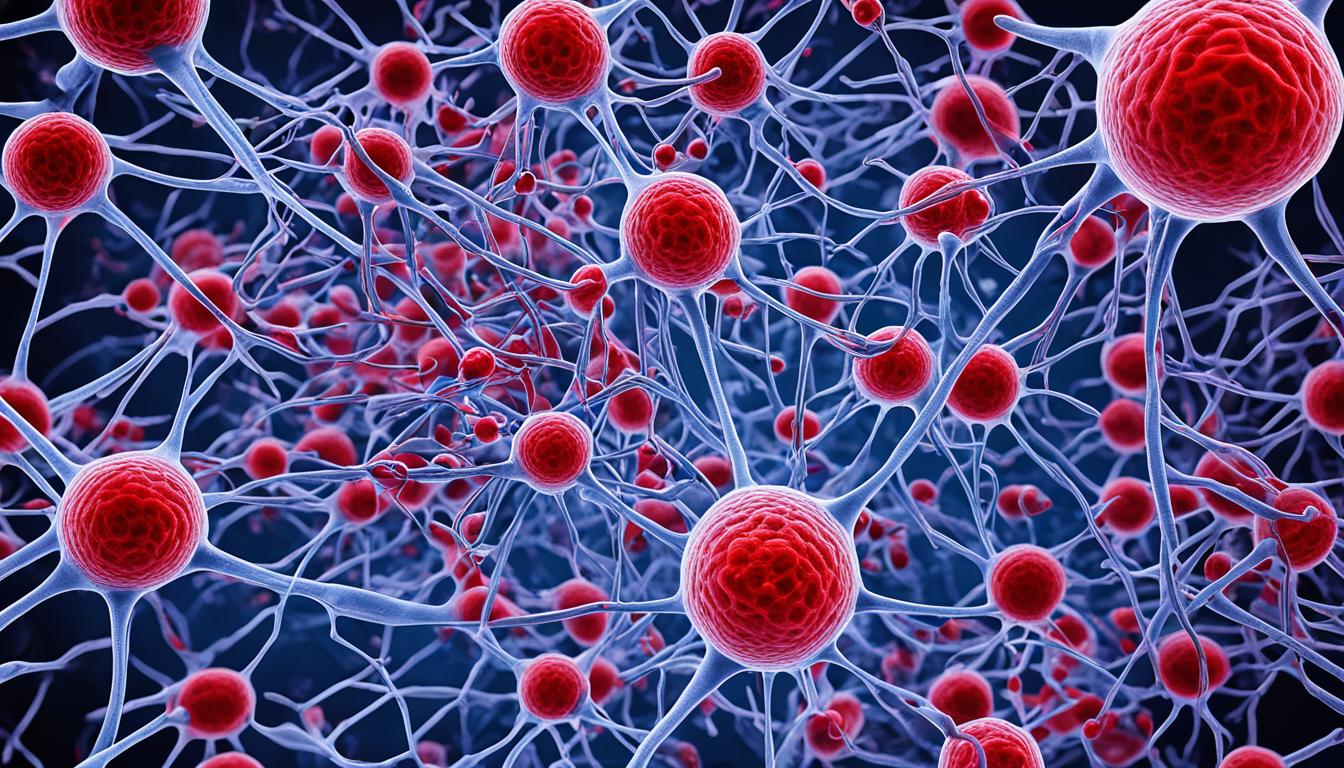Factor V Leiden is a genetic mutation that changes how our blood clots. This can lead to the risk of getting clots in the legs or lungs. Not everyone with this issue will have clotting problems, but it’s possible. The risk is higher when both parents pass on the gene. Factors like not moving a lot, taking certain hormones, getting surgery or being hurt, and your blood type can also affect the risk.
If you have Factor V Leiden, you might feel pain, swelling, or see redness. You could also have a hard time breathing, chest pain, or cough up blood. If any of these symptoms show up, get help fast. A simple test can show if you have the mutation. This way, you can manage the problem early.
Doctors can use medicines to lower the chance of more clots and keep blood flowing well. Also, staying active and keeping a healthy weight can reduce the risk. Scientists are looking into how stem cell therapy might help with Factor V Leiden.
Key Takeaways:
- Factor V Leiden is a genetic mutation that increases the risk of abnormal blood clots.
- Most individuals with Factor V Leiden do not develop abnormal clots, but those who do may face severe complications.
- Factors such as immobility, hormone use, surgeries or injuries, and specific blood types can further increase the risk of blood clots.
- Common symptoms of blood clots include pain, swelling, shortness of breath, chest pain, and coughing up blood.
- Genetic testing is available to diagnose Factor V Leiden.
- Treatment options include anticoagulant medications, lifestyle modifications, and ongoing research into stem cell therapy.
Diagnosis and Treatment of Factor V Leiden
Finding out if someone has Factor V Leiden starts with a blood test. This test confirms if you have the gene mutation. If you have had dangerous blood clots, your doctor might give you medications to make your blood thinner. These medicines help lower the chance of having more clots. But, if you have the mutation and haven’t had clots, you might not need these medications.
If you’re getting ready for surgery, the doctors may tell you extra steps to avoid clots. They might have you take blood thinners for a while. They could also suggest wearing leg wraps or special socks to help your blood circulate. After surgery, moving around early can jumpstart the blood flow in your legs. All of these steps together can make the chances of blood clots much lower.
For those with Factor V Leiden who sit still for a long time, like on a plane, it’s crucial to move their legs often. Using compression stockings is another good idea. They help with blood flow, which can prevent clots.
If you have Factor V Leiden, it’s important to talk to your doctor about medications with estrogen. These medications could up your risk of clots. So, you and your doctor should chat about any risks before deciding your next steps.
Precautions for individuals with Factor V Leiden:
- Undergo a blood test to diagnose the presence of the gene mutation
- Discuss the use of blood-thinning medications with a healthcare provider
- Follow recommended precautions before and after surgery
- Maintain regular leg movement during periods of immobility
- Consider using compression stockings to promote healthy blood circulation
- Carefully evaluate the risks and benefits of estrogen-containing medications
| Treatment | Description |
|---|---|
| Blood Test | A diagnostic measure to confirm the presence of the gene mutation. |
| Blood-Thinning Medications | Prescribed to reduce the risk of further clot formation. |
| Surgery Precautions | Extra measures taken to prevent blood clots during and after surgery. |
| Leg Movement and Compression Stockings | Maintenance of leg movement during immobility, such as long plane trips, and considering the use of compression stockings to promote blood circulation. |
| Evaluation of Estrogen-Containing Medications | Discussion of risks and benefits with a healthcare provider to minimize the risk of blood clots. |
Conclusion
Factor V Leiden is a gene that runs in families and can cause blood clot issues. Many people with this gene do not have blood clot issues. But for those who do, the troubles can be serious.
A simple blood test can tell if someone has the gene. Doctors may suggest certain medicines to lower the chance of blood clots. People with Factor V Leiden should know the things that might trigger blood clots. These include not moving for a long time, using certain hormones, having surgery or being injured, and specific blood types. Taking care and preventing blood clots is very important.
Scientists are looking into using stem cell therapy to treat this gene. It’s key for those affected to keep in touch with their doctors and follow the treatment plans closely. This helps in managing Factor V Leiden well.

